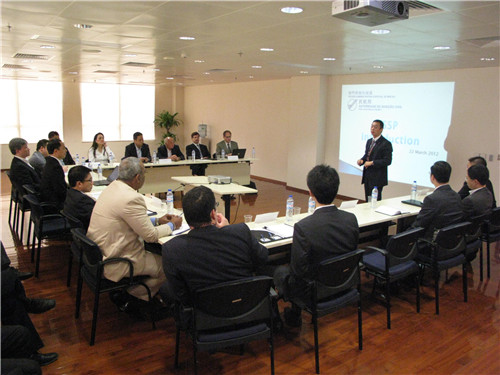
 {{_.$tools.formatDate(item.publishTime, 'yyyy-MM-dd')}} {{item.title}}
{{_.$tools.formatDate(item.publishTime, 'yyyy-MM-dd')}} {{item.title}} 
AACM promotes Macao SAR State Safety Programme and hopes to collaborate with the industry to strive for good safety management

AACM promotes Macao SAR State Safety Programme and hopes to collaborate with the industry to strive for good safety management 2012-03-22
To work together with the industry to strengthen the management of safety, create a good safety culture and comply with the requirements of the International Civil Aviation Organization (ICAO), the Civil Aviation Authority of Macao SAR (AACM) commissioned the project of Macao SAR State Safety Programme (SSP) in 2010 following the requirements of the Convention on International Civil Aviation (the Chicago Convention). AACM is now working on Phase Two of the three-phased project. With the objective of working hand in hand with the industry to achieve a higher level of safety, AACM invited the industry leaders and safety managers to a briefing on “SSP Introduction” on 22 March 2012 to explain to them the programme and how it interacts with the Safety Management System (SMS) of the operators. The safety data exchange and analysis concept was also explained. AACM will collaborate with the industry to implement the SSP and the SMS respectively, contributing to the long-term and effective management of safety in Macao.
The management of safety refers to the state safety programme (SSP) and the safety management system (SMS), the former being the responsibility of the regulatory body and the latter being the responsibility of the operators. To explain further, SSP is a set of rules aiming at improving safety, which includes setting safety policies and objectives, safety risk management and safety assurance policies. The safety programme is to be implemented by the regulatory authority. The project of the SSP currently worked out by AACM is the illustration of safety management implementation. The SMS, on the other hand, is to be implemented by the airlines, maintenance organizations, air traffic service providers and the airport operators. The components of SMS include organization structure, accountability, policies and procedures relating to safety management. In compliance with the Convention on International Civil Aviation, Macau International Airport, all local airlines and the ground handler have already implemented their respective SMS in or before 2009.
In this briefing, AACM gave an overview of the SSP theories, its implementation status, the concept of safety data collection and exchange as well as a series of tasks relating to the enhancement of Macao’s safety level. The SSP is a cross-year important project of AACM and for this reason, a cross-department task force was established to work it out. The development of the SSP comprises three phases. Phase One started in April 2010 and was concluded in July 2011. During this phase, AACM has devised the Macao SAR Safety Policy, the SSP Manual, the SMS Audit Guidelines and the SMS Requirements Update. As AACM always gives high importance to staff training, the Authority has continually sent their inspectors to receive overseas training in Kuala Lumpur and Bangkok on SSP considering that the inspectors should be properly trained to carry out safety oversight tasks. In addition, the Authority invited an expert from Cooperative Operational Safety & Continuing Airworthiness Programme - South East Asia, a technical unit under ICAO, to come to Macao in 2011 to give a training course to AACM inspectors on how SMS should be effectively implemented.
In addition, to assess the compliance of the SMS by the operators and their performance, and to ensure that the SSP and the SMS will work together effectively, AACM has requested the operators to submit a report on their safety targets and the relevant performance based results on an annual basis.
It is the wish of all aviation regulatory authorities to go ahead the occurrence of safety risks and resolve the safety concerns at the earliest time. However, the reality has indicated that it is not possible to completely get rid of incidents. It is however possible to implement safety programmes to find out the factors leading to safety concerns and take corrective actions beforehand in order that the possibility of incident occurrences can be reduced to a minimum. Safety is therefore defined by ICAO as “the state in which the possibility of harm to persons or of property damage is reduced to, and maintained at or below, an acceptable level through a continuing process of hazard identification and safety risk management.” On this concept, the Macao SAR SSP therefore aims at improving the internal management of safety by the regulatory authority and the industry, and taking advantage of risk management to remove risks or reduce risks to an acceptable level. In Phase Two of the SSP project, AACM puts emphasis on safety risk management and safety assurance. The Authority has discussed individually with each operator to define safety performance indicators and the acceptable level of safety.
The collection of data from different sources provides the basis for a solid understanding of the strengths and weaknesses of aviation operations. For this reason, AACM has started to establish the safety risk information database and is planning to sign Memorandum of Understanding with the operators on the exchange of safety data. In consideration that safety data are sensitive and should be protected, the data collected or shared out by AACM will be treated confidential and de-identified. The data will not be used for disciplinary purposes but only for analyzing factors for safety concerns.
Phase Three of the project will start in 2013. AACM will carry out annual review on the safety performance of the operators, continue with the safety data exchange and safety communication with the industry.
The President of AACM, Mr. Chan Weng Hong said, “Safety is the priority in the air transport service. Safety covers many areas and is a continuing task. The effective implementation of aviation safety depends on whether or not the regulatory authority and the industry can work together to define the correct direction, whether or not the standard procedures and the discipline are strictly complied with, and whether or not the staff have received training and so on. The implementation of the SSP and the SMS is to enhance the mutual understanding from top management down to the technical staff towards the safety concept as well as create a good safety culture in the entire working environment, so that all people can stride forward for the healthy development of aviation safety.”
The attendees of the briefing were representatives from CAM-Macau International Airport Co. Ltd., the Administration of Airports Ltd., Air Macau Co. Ltd., East Asia Airlines Ltd., JetAsia Ltd., Macau Jet International Co. Ltd. and Menzies Macau Airport Services Ltd.

The Civil Aviation Authority of Macao SAR invited the aviation industry to a briefing on the Introduction of “Macao SAR State Safety Programme” on 22 March 2012.
-
Previous
Mainland China, Hong Kong and Macao held regular ATC meeting to study on driving forward the PRD Region Air Traffic Management Planning and Implementation -
Next
AACM approves Chinese New Year extra and charter flights, and appeals to passengers to comply with air transport and security requirements
























